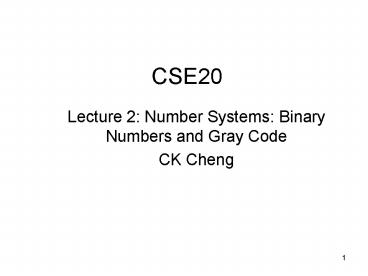CSE20 PowerPoint PPT Presentation
Title: CSE20
1
CSE20
- Lecture 2 Number Systems Binary Numbers and
Gray Code - CK Cheng
2
Number Systems
- Introduction
- Binary Numbers
- Gray code
- Negative Numbers
- Residual Numbers
3
2. Binary Numbers iClicker
- What is the extent of a binary number system
- A. Coverage of integer and floating point numbers
- B. Mechanism of addition and subtraction
operations - C. Operations of logic functions
- D. All of the above
- E. None of the above.
4
2. Binary Numbers
- Definition (radix 2)
- Enumerations (value -gt index)
- Addition (logic -gt hardware)
5
2.1 Definition of Binary Numbers
- Format An n digit binary number
- (bn-1, , b1, b0)2 where bi in 0,1 for 0lt i lt
n - Value bn-12n-1 b121b020
- Non-redundancy The system is non-redundant, i.e.
different binary numbers represent different
values.
6
2.2 Enumeration of Binary Numbers
1 digit
2 digits
3 digits
4 digits?
id b2b1b0
0 000
1 001
2 010
3 011
4 100
5 101
6 110
7 111
id b1b0
0 00
1 01
2 10
3 11
id b0
0 0
1 1
id b3b2b1b0
0 0000
1 0001
2 0010
3 0011
. .
. .
. .
14 1110
15 1111
An n digit binary code covers numbers from 0 to
2n-1.
7
2.2 Enumeration of binary numbers iCliker
- When we enumerate binary numbers
- (b3b2b1b0)2 from 0 to 15, the sequence of b3
should be - A. 0101010101010101
- B. 0011001100110011
- C. 0000111100001111
- D. 0000000011111111
8
2.3 Addition of Binary Numbers
- Given two binary numbers A B, we derive binary
number S so that the value of S is equal to the
sum of the values of A B, i.e. - (an-1,a1a0)2(bn-1b1b0)2(sn-1s1s0)2
- Caution Overflow, i.e. the sum is beyond the
range of the representation.
9
2.3 Addition iClicker
- Given two binary numbers
- A(an-1,a1a0)2 and B(bn-1b1b0)2
- what is the largest possible value of AB?
- 2n1
- 2n1-1
- 2n1-2
- None of the above
10
2.3 Addition of Binary Numbers
- Equality of addition
- (an-1,a1a0)2(bn-1b1b0)2(sn-1s1s0)2
- That is to say
- an-12n-1a121a020bn-12n-1b121b020
- (an-1bn-1)2n-1(a1b1)21(a0b0)20
- sn-12n-1s121s020
11
2.3 Addition of Binary Numbers
Examples
b2 b1 b0 Value
0 0 0 0
0 0 1 1
0 1 0 2
0 1 1 3
1 0 0 4
1 0 1 5
1 1 0 6
1 1 1 7
8 4 2 1
0 0 1 1
0 1 0 1
8 4 2 1
0 0 1 1
0 1 1 0
12
2.3 Addition of Binary Numbers
Biti1 Biti Biti-1
Carryi1 Carryi
ai ai-1
bi bi-1
Sumi Sumi-1
Formula for Bit i Carryiaibi
2xCarryi1Sumi
13
2.3 Adding 2 bits in a digit
a b Carry Sum
0 0 0 0
0 1 0 1
1 0 0 1
1 1 1 0
Formula ab 2xCarry Sum
14
2.3 Adding 3 bits in a digit
id a b c Carry Sum
0 0 0 0 0 0
1 0 0 1 0 1
2 0 1 0 0 1
3 0 1 1 1 0
4 1 0 0 0 1
5 1 0 1 1 0
6 1 1 0 1 0
7 1 1 1 1 1
Formula abc 2xCarry Sum
15
3. Gray Code
- Introduction
- Example
- Construction
- Comments
16
3.1 Gray Code Introduction
Gray Frank Gray patented the code in 1947 A
variation of binary code The code will be used
for logic operation (CSE20, CSE140) Feature only
one bit changes for two consecutive numbers
17
3.2 Gray Code Example
2 digits
3 digits
id b1b0 g1g0
0 00 00
1 01 01
2 10 11
3 11 10
id b2b1b0 g2g1g0
0 000 000
1 001 001
2 010 011
3 011 010
4 100 110
5 101 111
6 110 101
7 111 100
Note the difference of the first and last rows.
18
3.2 Gray Code
id b3b2b1b0 g3g2g1g0
0 0000 0000
1 0001 0001
2 0010 0011
3 0011 0010
4 0100 0110
5 0101 0111
6 0110 0101
7 0111 0100
8 1000 ?
9 1001
10 1010
11 1011
12 1100
13 1101
14 1110
15 1111
3 digits
id b2b1b0 g2g1g0
0 000 000
1 001 001
2 010 011
3 011 010
4 100 110
5 101 111
6 110 101
7 111 100
19
3.2 Gray Code iClicker
- A 4-digit Gray code (g3g2g1g0) at id8 is written
as (ref previous page) - (0101)
- (0110)
- (1100)
- None of the above
20
3.3 Gray Code Construction
- Construction of n-digit Gray code from n-1 digit
Gray code - Copy the n-1 digit Gray code for the top 2n-1
rows. Fill 0 at digit gn-1 in the top rows. - Reflect and append the n-1 digit code for the
bottom 2n-1 rows. Fill 1 at digit gn-1 in the
bottom rows.
21
3.4 Gray Code Comments
- There are various codes that satisfy the Gray
code feature. - Gray code saves communication power when the
signals are continuous in nature, e.g. addresses,
analog signals - Gray code facilitates code checking when the
signals are supposed to be continuous in value. - For arithmetic operations, we need to convert the
values.

